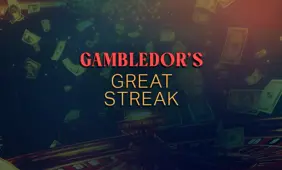Hit and Run Casino Strategy – The Art of Knowing When to Walk Out

There are multiple groups online discussing the tactic of playing blackjack until a pre-determined profit is obtained and then walking away without risking those winnings. The term “hit and run” in casinos almost suggests it might be a forbidden strategy or an illegal move against the house. All I can say is we have a very different definition of the term “hit and run”.
What Is a Typical Hit and Run Tactic in Casinos
As Elliot Gould informed George Clooney and Brad Pitt in the first (modern) Ocean’s Eleven movie, typical hit and runs in gambling terms refer to players boosting cash from the tables and trying to get out of the door before being tazed, knocked cold or shot in the back. According to his character only one such attempt ever made it outside and guess which one got shot?
A more profitable (and occasionally successful) hit and run tactic might be an ‘outside’ deck switch where every card in play is swapped under cover of some serious misdirection and replaced with a duplicate deck in a pre-determined order ready to empty the chip tray; the problem being that you have to hit that stacked deck hard and fast and get out of Dodge before you wake up security and a cold deck will always wake up security or management.
On “The Takedown” for Court TV, we choreographed the switch of an entire six deck shoe while blocking the eye in the sky then walked the casino’s genuine shoe out the front door before our big player arrived at the table to started winning like crazy. The move worked but the cold deck was too strong so when Michael was suddenly holding every single chip on the table, he was quickly invited for a friendly chat upstairs.
This was definitely a case of “hitting” and forgetting to “run”!
Of course, the goal here was to make a point to the casino that such a move was possible and since we theoretically had a “get out of jail” card, we deliberately over-played our hand!
In real life, we might have walked our big player after a predetermined profit, but a more sophisticated approach might be to start losing in order to send half our winnings back to the house while still getting away with a healthy reward. This sounds good in theory but remember - a great cold deck will wake the dead, so the best hit and run strategy is grab what you can, get out and don’t come back until the heat cools down.
The “One Hit Wonders” Hit and Run Scams
Less sophisticated scams are more like “one hit wonders” and rules have changed over the years to prevent or confound this type of hustle. Mostly they work with pretended or genuine confusion between a player and the dealer (or dealers).
A simple example is when a hustler approaches a blackjack table where the dealer is near the end of his or her stint at the table and their attention is not as high as it might have been at the start of their shift. With a bunch of black checks in one hand, the hustler tosses one of these $100 chips halfway into a betting box as they say something unintelligible before scanning the casino as if looking for their long-lost Pappie.
The timing is important with the chip being dropped between hands after one round of cards is collected and the next is just about to be dealt. The hustler’s pretended distraction, as they look away from the table helps with what is about to transpire and it’s important the scammer doesn’t see the dealer repositioning their bet (inside the box) before dealing cards.
As soon as the first card is dealt, the hustler quickly takes one of two courses of action: If the first card is a ten or an ace, they let the hand play out since this gives them a much better chance of winning but if any other value lands first, they immediately say “Hey, where’s my change?”
This entirely faked scenario allows the hustler to claim they asked for change and never intended to bet and in most cases, this might be allowed while the dealer apologizes for their “misunderstanding” but would almost certainly refer the incident to their manager. A smart hustler can only get away with this type of scam once per establishment so this is another example of what I would call a hit and run in casinos.
Rough Hustlers vs Weak Dealers
Similar scams take advantage of dealer procedures or individual dealer weaknesses.
Hand-dealt games where an inexperienced or tired dealer is pitching cards less accurately allows some hustlers to grab other players’ cards if they’re dealt too close (and is glimpsed during the deal). In the past, after cards are collected into the discard tray, some rough hustlers were known to claim a mistake on the dealer’s part, arguing that their cards were still good, but this is now impossible to pull off since any discrepancy can be quickly verified by video playback.
Hustlers bold enough to try such ruses are usually not dumb enough to repeat them too often, but some might go for it several times if a dealer doesn’t object, or security is a little loose. For example, an old ploy when doubling down was to lift a stack of chips that were in the betting box to apparently verify how many had been bet, secretly adding a palmed chip to that stack before matching the stack with more chips. Dealers would be quick to tell the player (cheater) not to touch their bet and the player (cheater) would simply apologize and proclaim his or her ignorance (known as “Playing the Iggy”).
These are legitimate hit and runs (in my view) mostly because they can all end in a trip to jail or the hospital!
But what about just playing into profit then walking away with the casino’s cash?
Do it!
Just don’t depend on it.
Any casino worth its math will gladly invite anyone willing to risk their money according to the rules of the games they offer and while they might prefer you to keep playing (since the chances of winning are always against you) you’re entirely within your rights to make one bet, win a fortune then head for the buffet.
Professional blackjack teams operate within a predetermined profit and loss window where they depend on an advantage secured through their preferred strategy (such as card counting, shuffle tracking etc) to push them eventually give them a profit so will happily reach for more cash when they are in the hole.
These advantage players will also continue playing when they’re winning and stop when their luck swings the other way and there’s nothing illegal about any of it.
In fact, one of the advantages of being a player is you can always stop betting whenever you like according to any strategy you wish to play. Similarly, casinos are free to ask anyone not to play at their tables for any reason and this is also perfectly fair with one exception.
I was once told by a Casino manager that they loved to find a card counter on a negative swing and watch them lose until they started to claw back their losses and at that point, they would be invited to leave by the friendly people of house security.
Think about that: if the house identifies a card counter, they are entirely within their rights to back that card counter off but by not doing so until he stops losing, they are arguably stealing from that player since - from the moment they knew the player is counting - they were allowing them to lose money without the intention of letting them win that money back again.
If they simply kicked them to the curb as soon as they were identified, that would be fair but to let any player keep losing like this is tantamount to theft in my opinion.
So, when it comes to this idea of hitting the tables and running once you win: Play your best game and take a walk away as soon as you make more money than you arrived with.
There’s really no need to run.





Review this Blog
Leave a Comment
User Comments
comments for Hit and Run Casino Strategy – The Art of Knowing When to Walk Out